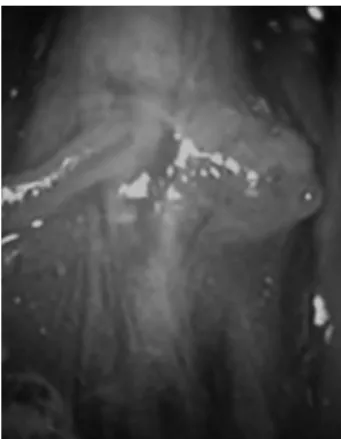345
CLINICS 2010;65(3):345-6
TECHNICAL NOTE
I Instituto de Neurocirurgia da Amazônia Ocidental (INAO) - Porto Velho/
RO, Brazil.
II Interventional Neuroradiology, Instituto de Radiologia do Hospital das
Clínicas da Faculdade de Medicina da Universidade de São Paulo (USP) - São Paulo/SP, Brazil.
III Instituto Nacional de Neurologia y Neurocirurgia “MVS” (INNN) –
Mé-xico/DF, México. Email: rivanov72@usp.br Tel.: 55 11 3069.7065
EFFECTS OF THE MODIFICATION OF THE AORTIC
BIFURCATION GEOMETRY: A TECHNICAL NOTE
REGARDING A NOVEL MODEL FOR EXPERIMENTAL
ATHEROSCLEROTIC AND ANEURYSMATIC LESIONS
doi: 10.1590/S1807-59322010000300018
Rogelio Iván Ortiz-Velázquez,I,II,III José Guilherme Mendes Pereira Caldas,II Bruno Carmello Rocha Lobo,I Jorge Arturo
Santos-Franco,III Rodrigo Mercado-Pimentel,III Rogelio RevueltaIII
INTRODUCTION
Although the deining feature of the vascular tree is its repeated bifurcation, only speciic arterial bifurcations are frequent sites for the development of obstructive atherosclerotic and aneurysmatic lesions.1 Despite the fact
that several experimental approaches are available in which these lesions can be induced, no consensus has been reached regarding their pathogenesis.2 However, in all of these
models, the altered hemodynamics have been identiied as a major inluence in pathogenesis.3 This aspect motivated
the investigation of the vascular low patterns linked to these particular bifurcations.4 In these bifurcations, the
low at the artery level is complicated by several features;5,6
however, these effects are minor compared to the anatomical variations in the bifurcation.7 Therefore, these aspects
prompted us to determine the effects of modiications to the geometry of aortic bifurcation.
MATERIALS AND METHODS
The institutional guidelines for research involving animals were followed, and the experimental study was reviewed and approved by the local committee for ethics (Approval no. 382/06). Fifteen male Wistar rats each weighing 250 g
were anesthetized via an intraperitoneal injection of xylazine hydrochloride (10 mg/kg body weight; Pizer Pharma) and ketamine (100 mg/kg body weight; Pfizer Pharma) and were placed on a thermoregulated surgical table. The body temperature of the rats was maintained at 37 °C. Supplemental doses of the anesthetic were given as needed to maintain a uniform level of anesthesia allowing spontaneous breathing. After supine positioning of the animal, an abdominal midline incision was made. Using a surgical microscope, the aortic bifurcation was approached, and the iliac vessels were isolated distal to the site of bifurcation. The modiication of the aortic bifurcation geometry was performed by tunneling the distal end of the iliac artery in the iliolumbar muscle at the root of the inferior member (Fig. 1). Left nephrectomy and ligation of the right inferior renal artery were performed to enhance the vascular stress. The abdominal incision was sutured in a unique layer using a 4–0 mono-nylon running suture, and the animals were kept in cages with food and a solution of 1% NaCl that was provided as drinking water ad libitum. All
animals were subjected to the same proposed method. After six months of monitoring, the animals were anesthetized,
346
CLINICS 2010;65(3):345-6 Experimental atherosclerotic and aneurysmatic model
Ortiz-Velázquez RI et al.
and the aortic bifurcation and the proximal iliac arteries were inspected and subsequently removed for histopathological analysis. The animals were killed by a massive intraperitoneal injection of sodium pentobarbital (200 mg/kg body weight; Sanofi Aventis). The arterial samples were fixed in 10% neutral buffered formalin for 48 hours and then embedded paraffin blocks in their anatomic form (Y-shape). Serial 5-mm slices were sectioned perpendicularly and parallel to the long axis of the vessels, and the slices were stained using Hematoxylin & Eosin following the Masson and Verhoeff techniques. The slices were observed under an optical microscope to identify inlammatory cells, bleeding, ibrosis, thickening/thinning, and interruption/disorganization of the layers of the arterial wall.
RESULTS
Four rats developed aneurysmal dilatations at the aortic bifurcation (Fig. 2). Subsequent histopathological analysis of these lesions showed a disorganization of the endothelium, progressive loss of the muscle and elastic layers and substitution of the muscle and elastic layers by disorganized collagen tissue. This connective tissue showed a similar morphological pattern as the one described for atherosclerotic plaques and spontaneous aneurysms in humans (Figs. 3 and 4).
CONCLUSIONS
In rats with enhanced vascular stress, the modiications to the aortic bifurcation geometry generated hemodynamic alterations resulting in abnormal vascular remodeling with atherosclerotic-like lesions and lead to the formation of aneurysms.
DISCLOSURE: This work was supported by a grant from the FAPESP (06/03977-1).
Figure 2 - The wide-base saccular lesion was located adjacent to the aortic bifurcation.
Figure 4 - Masson’strichromestained section from the aortic wall at the aneurismal lesion (40 x). Notice the substitution of the normal elements of the arterial wall with ibrous connective tissue.
REFERENCES
1. Cheng C, Tempel D, van Haperen R, van der Baan A, Grosveld F, Daemen MJAP, et al. Atherosclerotic lesion size and vulnerability are determined by patterns of luid shear stress. Circulation. 2006;113:2744-53.
2. Hashimoto N, Handa H, Hazama F. Experimentally induced cerebral aneurysms in rats. Surg Neurol.1978;10:3-8.
3. Hashimoto N, Kim C, Kikuchi H, Kojima M, Kang Y, Hazama F. Experimental induction of cerebral aneurysms in monkeys. J Neurosurg.1987;67:903-905.
4. Cebral JR, Castro MA, Appanaboyina S, Putman C, Millan D, Frangi AF. Eficient Pipeline for Image-Based Patient-Speciic Analysis of
Cerebral Aneurysm Haemodynamics: Technique and Sensitivity. IEEE T Med Imaging. 2005;24:457-67.
5. Ku DN. Blood Flow in Arteries. Annu Rev Fluid Mech. 1997;29:399-434.
6. Taylor C, Draney MT. Experimental and computational methods in cardiovascular luid mechanics. Annu Rev Fluid Mech. 2004;36:197-231.
7. Sitzer M, Puac D, Buehler A, Steckel DA, von Kegler S, Markus H, et al. Internal carotid artery angle of origin a novel risk factor for early carotid atherosclerosis. Stroke; 2003;34:950-5.

